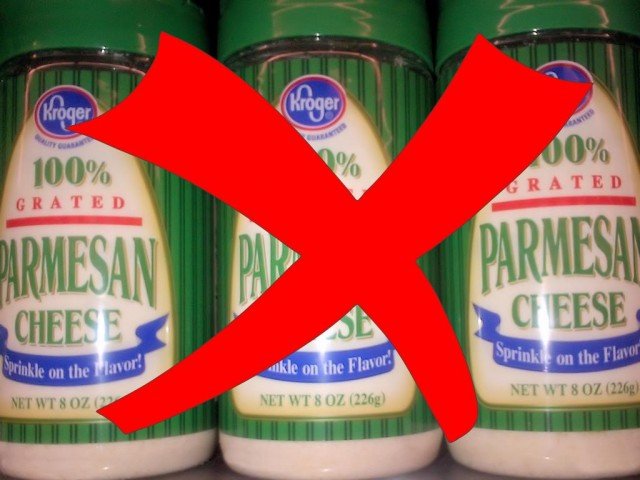Grated Italian Cheese has come a long way from when there were very few if any options available for purchase in your typical grocery store. Most of us remember the green cardboard tube of Grated Parmesan Cheese that had a shelf life of a couple of years and lasted longer in the refrigerator after being open than that jar of hotdog relish. It lasted a long time for several reasons. The first reason is that the flavor imparted by the grated cheese was so light that no matter how much you sprinkled on your pasta you still did not taste the cheese, therefore it was not used. The second and third reason is that the “grated cheese” you were using was mixed with small amounts of cellulose powder (to prevent caking) and potassium sorbate (to maintain freshness).
Thankfully the options available to most of us have expanded well beyond the green cardboard tube. You can now purchase both grated and shredded; Parmesan, Romano or Asiago and for the most part the options are either bagged or sealed in containers that are kept in the refrigerated section of the grocery store with fancy sounding Italian brand names. These are a definite improvement, but still not the best option available.
For those that truly want to experience the true pleasure of that salty sharpness that fresh grated Italian cheese brings to a meal there is another option.The old way and infinitely more difficult way was to hand grate the hard cheese and somewhere along the way some knuckle skin would find its way onto your dish of pasta. I do not remember where or when I first tried the idea, but now to make fresh grated hard Italian cheese I use a small handheld mixer utilizing the small food processor blade attachment / container.
Step 1: Purchase a small wedge of hard Italian cheese and cut it into small chunks. I usually keep one or two wedges of cheese in the refrigerator. They last for a very long time and nothing worse than not have grated Italian cheese in the house when you need it.
Step 2: Place a small handful into the handheld food processor.
Step 4: Turn on the processor for 20 to 30 seconds. When all of the chunks of cheese have been ground to the size of a grain of sand or smaller you can stop. Every now and then a chunk of cheese will catch on a blade and jam the handheld mixer. This is common and usually happens because you placed too much cheese in the container to be ground. It will require three to four batches to process a small wedge of hard cheese.
Step 5: Pour the contents into an air tight container and store in the refrigerator until needed. In order to maintain the best freshness, only grind the amount of cheese you need for that week. Wrap the remaining chunk of cheese in Saran wrap and store in the refrigerator.
You can always purchase a handheld hard cheese grater for the ultimate freshness in grated Italian cheese, but to me that is just one more piece of equipment in the kitchen that has a singular use and takes up limited space. I more prefer kitchen equipment that can be used for a variety of food preparation activities.
For years when I would visit my family in Delaware, I would bring back a pound of fresh grated Locatelli hard Italian cheese that was purchased from Pappas Market in Wilmington, DE. I always thought that Locatelli was a type of hard Italian cheese that was hard to find. Little did I know that Locatelli was in fact the brand name of Pecorino Romano and not a type of cheese? Imagine my surprise when I first saw Locatelli being sold at the local HEB in Katy, TX.






